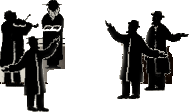In 1939, the USSR concluded the treaty of friendship with Hitler's Germany. Anti-fascist propaganda was stopped. Jews were removed from the People's Commissariat of Foreign Affairs. After the annexation of some Western territories (in accordance with secret paragraphs of the pact), millions of Jews who had lived in conditions of ethnic and cultural autonomy (in spite of the state's anti-semitism) and with a well-developed infrastructure of Jewish organizations found themselves in the USSR. Their mother tongue was Yiddish. The Yiddish schools and periodicals remained, but the first days of Soviet occupation saw the repression of Jewish activists, and especially Zionists. "Socially alien" Jews became victims of mass deportations. At the same time, many Jews in the new Soviet territories were members of Communist organizations and they took an active part in their work.
According to the population census of 1939, there were about 3,000,000 Jews in the USSR. In 1939-1940, more than 2,000,000 more were added (including about 200,000 refugees from Poland). When the Great Patriotic War began, the danger of the total extermination of Jews became real. The evacuation of non-combatants was poorly organized. Up to 3,000,00 Jews found themselves under Nazi rule. During the first days of the war, Hitler's men were directed to exterminate the entire Jewish population. The program of a "final solution to the Jewish problem" was adopted by Nazi authorities in 1942. German troops were followed by so-called Einsatskommandos. With help of local collaborators, they organized "actions" - they registered every Jew, gathered them together, and then shot them in an isolated place. The ravine of Babii Yar near Kiev became a terrible symbol of the genocide of Soviet Jews; on September 29-30, 1941, tens of thousands of Jews were killed there.
By the winter of 1941-1942, most of Jews in the Baltic States, Eastern Ukraine, Eastern Belorussia and Moldavia had been exterminated. However, the need for manpower forced the Nazis to postpone the "final solution of Jewish problem". The ghettos in Riga, Minsk, Baranovichi and other cities remained. Able-bodied Jews in a ghetto had to work as slaves; disabled people were doomed to die of starvation and diseases. In 1942, the mass removal of Jews from the ghettos to special death camps began; the camps were situated in Treblinka, Sobibor, Belzec and Chelmno. Later, Auschwitz became the center of the extermination. Six millions Jews from the USSR and European countries died in the gas chambers during 1942-1944. Only very few Jews were saved by non-Jewish neighbors. The names of those heroic individuals - "the world's zaddiks" - are remembered at Yad Va-Shem in Jerusalem.
Unarmed, alone against a powerful extermination machine, Jews resisted desperately. Underground organizations acted in the ghettos; they prepared arms and organized escape to the woods. As a form of spiritual existence, there were Jewish theaters, various circles and religious organizations in the ghettos. Some ghettos rose up. However, most men in the underground left the ghettos to organize Jewish guerilla groups or to join the Soviet partisans. Sometimes, Jewish guerillas faced anti-semitism among resistance leaders. By decision of the Soviet Command, Jewish detachments were disbanded to reinforce non-Jewish ones. Some Jews were disarmed and abandoned to their fate. Nationalist Polish and Ukrainian detachments (Armia Krayova and the UPA) killed Jews themselves. However, many Soviet guerilla detachments sent Jews across the front to the East to save them from death.
During the Great Patriotic War, 40% of Soviet Jewish men fought at the front; 200,000 of them were killed in battle. Many displayed heroism. 148 Jews were honored as Heroes of the Soviet Union; 12 Jews became holders of the full Order of the Glory. Two Jews covered enemy embrasures with their bodies; 13 pilots crashed their burning planes into the enemy. General Ya. Kreizer, Major Tc. Kunikov, private L. Papernik and thousands of other Jews became famous for their feats of arms. Many Jews made a substantial contribution to the victory as they worked in the rear. Twelve of them were honored as Heroes of Socialist Labor, such as People's Commissar of Ammunition B.L. Vannikov, the director of a tank factory I.M. Zaltsman, aircraft designer S.A. Lavochkin, and others. Nevertheless, already in 1942, recommendations for rewards began to be postponed or declined, the promotions became difficult. Propaganda hushed up the feats of Jews.
In the middle of December,1941, thanks to the efforts of distinguished Jewish public figures, the Jewish Anti-Fascist Committee took shape. Its leaders were S.M. Mikhoels, I.S. Fefer, Sh.Z. Galkin, P.D. Markish, L.S. Shtern, B.A. Shimeliovich, D.R. Bergelson and L.M. Kvitko. Stalin wanted to use the Committee to draw the help of American Jews. Jewish Anti-Fascist Committee played an important role for the USSR in winning over US public opinion. Because of the trips and speeches of S.M. Mikhoels and other members of the Committee, substantial funds were gathered by American Jews to send to the USSR. At the end of the war, thanks to the efforts of the Committee, they began to compose "The Black Book" - a memorial to the murdered Jews. However, the Committee's attempts to struggle against anti-Semitism within the USSR faced resistance from the authorities.
The activity of the Jewish Anti-Fascist Committee continued after the war. However, Communist authorities had already begun a policy of state anti-Semitism. Yet in 1943, leaders of the Committee appealed to the Central Committee of the VKP(B) with a project to create a Jewish Autonomy in Crimea where surviving Jews who had lost their families, their homes and jobs could find asylum. This project was shelved, and in 1948, it was recalled as a pretext to accuse the Jewish Anti-Fascist Committee of nationalism and separatism. In the beginning of 1948, in Minsk, S.M. Mikhoels was assassinated by MGB agents. The assassination was staged as an accident. The leaders of the Jewish Anti-Fascist Committee, as well as all Russian Jews, were already in mortal danger. However, action was postponed. The Committee, its periodical "Enikait" ("The Union"), and GOSET still existed; the latter was even named after Mikhoels.
In May, 1948, the state of Israel was declared. This caused an outburst of national feeling among Soviet Jews. In June, 1948, in the Moscow choral synagogue, a solemn ceremony was performed; 10,000 people attended it. Those ceremonies took place in certain other cities also. At first, the USSR tried to support Israel in its Near-Eastern policy. Volunteers prepared to leave for the Arab-Israel War. In September, 1948, Golda Meir - the first Israel ambassador to the USSR - came to Moscow. She met with the most distinguished representatives of Soviet Jewry and visited the Moscow synagogue. Her visit was warmly received by Soviet Jews, many of whom would pay for their support later. Support for the Jewish State was shown publicly. On the facade of Metropol hotel where G. Meir stayed, an Israel flag was displayed. The old Zionist Mogilevsky came there with a step-ladder, climbed up and kissed the edge of the flag. Then he was "helped" to descend.
All efforts to transform Israel into "The Seventeenth Republic" failed. There was no reason anymore to postpone the decimation of the Jewish Anti-Fascist Committee. In November, 1948, the Committee and its periodical newspaper were closed and the leaders were arrested. The case continued for some years. Jewish activists were tortured into confessing to espionage and high treason. Of those who were arrested and lived to see the trial, nearly all were sentenced to be shot in 1952. The repressions struck the authorities of the Jewish Autonomous Region, too. Simultaneously, the campaign against "cosmopolitanism" was in full swing. In the course of the campaign, unprecedented persecution of Jews took place; the figures of science and culture and industry top managers were among them. Almost all Jews lost their high positions; many lost all employment. Soviet ideology began to employ crude anti-semitism in propaganda. This policy relied on people's anti-semitic sentiments, which had intensified during the war.
The anti-semitic campaign reached its climax at the end of 1952. The doctors of the Kremlin Hospital, mostly Jews, were accused of sabotage. Their arrest was an excuse to launch a new anti-semitic action. Throughout the country, mass psychosis was provoked among the people; they were afraid of Jewish doctors. Mass dismissals were renewed. Jews suffered insults and violence on the streets, their neighbors attacked them. There were rumors of preparations to deport Jews to terrible places in Siberia or the Far East. Some Jews of high rank readied a cringing letter to the Central Committee of the Communist Party that offered to move the Jewish population to the Jewish Autonomous Region in order to protect Jews from "the people's righteous wrath". I. Erenburg, I. Dunayevsky, M. Reizen and Ya. Kreizer refused to sign it. Stalin's death in 1953, which coincided with the feast of Purim feast, halted this dreadful campaign.
In the years of the war, Soviet propaganda depicted Nazi cruelty, yet was silent on the theme of exterminationist policies aimed solely at Jews, not "Soviet citizens" in general. All efforts by the Jewish Anti-Fascist Committee to tell the world about the tragedy of Soviet Jews were suppressed. The "Black Book" was not published. Attempts to erect memorials in places of mass executions run were prohibited. Jewish themes in the press, literature and art were off limits. However, the tragedy Jews the had suffered demanded to be expressed. The memory of the Shoah lived in oral tradition. Unpublished correspondence in verses attributed to Erenburg and Aliger was dedicated to the theme of Jewish nationalism. Those verses were copied in writing, circulated, memorized by heart. Thus, the foundation of Jewish samizdat was laid.












![]()
![]()
![]()
![]()
![]()
![]()
![]()
![]()
![]()












